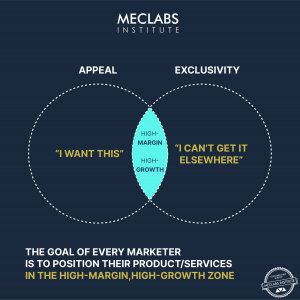Communicating Value Proposition: We answer questions from marketers and entrepreneurs
Every Wednesday, we hold a Marketing LiveClass as part of the AI Guild. Everyone is welcome to sign up for a free trial to the AI Guild so they can join and learn from these sessions, as we build marketing funnels with members of the AI Guild.
In the LiveClass, marketers and entrepreneurs can ask questions in the webinar chat. And we answer them right here…
Are we supposed to be framing this like we are talking directly to the customer? Like a headline? Or are we speaking of our customers as a third party?
This question is about how to write a value proposition.
MECLABS defines a value proposition as being the answer to the question, “If I am your ideal customer, why should I buy from you instead of any of your competitors?”
So you are answering a question the customer is asking (in their minds), and the first word in your answer should be “Because…”
You are not speaking about the customer as a third-party. You are speaking directly to the customer.
But the value prop is not a headline. The headline is the articulation of the value proposition. This is directly answering the customer’s question.
To do that, you need to figure out how to increase your customer intimacy and your customer wisdom. If you need to answer the customer’s question, you better understand what the customer wants and what your product delivers. This will help you optimize the communication of the value proposition, or make you realize that you need to create more or different value in the product itself.
To get you thinking for how to find those answers, here’s an example from Radhika Duggal, Chief Marketing Officer, Super…
“We literally stood up for research discipline, doing professional-quality quantitative market research and maybe mediocre-quality qualitative research, in-house producing five to six studies a year simply because we wanted to make sure as we were innovating, we were creating the right products. And we did this with the agreement from the product team that understanding and hearing from our customers really did matter.” (from Consumer Financial Services Marketing: Your customer is your most important stakeholder – podcast episode #39).
Drill down to micro niche?
To have a forceful value prop, the value proposition needs an only factor – a combination of appeal and exclusivity. The less tightly your ideal customer is defined, the harder it is to have that only factor.
For example, a cohort member had an ad and landing page that focused on business consulting. It would be very hard (but not impossible) to have an only factor for such a broad customer set.
However, he conducted competitive research with Bing AI using a methodology taught in the cohort and discovered the lack of high-quality support available to medium-sized businesses in the construction industry.
That is a much more tightly focused ideal customer set (I supposed some people might call it a micro niche), and therefore, it is far easier to identify and communicate an only factor and have a forceful value proposition.
To get more ideas for identifying your ideal customer, you can download 7 Steps to Discovering Your Essential Value Proposition with Simple A/B Tests.
Is it too early to join if you have not determined who your target audience is?
No, it is not too early to join the MECLABS SuperFunnel Research Cohort if you have not identified your target audience. In fact, using the thought tools in the cohort can help you determine your target audience (as discussed in the example above).
Another example is determining if your target audience for a landing page is a prospect or previous customer. This can affect what value proposition you feature on a landing page or in an offer. (Get more ideas on that in Value Sequencing Decider Graphic: What do your customers need to know, and when do they need to know it?)
Container is the quiz?
Your offer will tend to have two parts – the container and the content. For example, I consulted with a brand at IBM to help with their sales enablement early in my career. We brought sales information and case studies to a globally distributed sales team in an email newsletter.
But we realized that this was a highly mobile audience, and they wanted to spend as much time as possible with clients and potential clients. They didn’t want to read an email newsletter.
We changed the format and delivered the content through a podcast. This way, they could listen during their downtime while they were traveling – in the car, an airplane (before there was Wi-Fi on planes, and when laptop use was limited), etc. So it wasn’t taking time away from clients (traveling was downtime anyway). And they had a lot of this travel time to use up since they were highly mobile.
The most appealing container for your ideal customer – like in this question, a quiz – can help pull them into your landing page and your offering.
Of course, the container is just part of it, For more ideas on pulling your ideal customer into your offering, watch Above-the-Fold Energy: How to engage the prospect’s mind with a carefully crafted opening.
Possible to get a link to the 54, uh, things?
To help cohort members come up with ideas for their offer container, in the LiveClass we shared this article – Funnel Strategy: 54 elements to help you guide your buyers’ journey through the marketing funnel.
In the LiveClass chat, a cohort member shared a brilliant way she was using AI to get the most out of the article. I share it here if you would like to use her idea as well. “I copied those 50 and asked ChatGPT for an idea for my audience for each of those … good brainstorming exercise. Even got it to output in a table so it pastes into a spreadsheet …”
How does the shorter landing layout relate to the layout diagram that we were following?
The layout diagram refers to the MECLABS Landing Page Blueprint. The blueprint features eight micro-yeses you should achieve from the customer.
But just because you need to win these eight yeses, does not necessarily mean you need to have a long landing page.
For example, one of the micro-yeses you have to secure is “Yes, I believe.” The amount of information you need to win this micro-yes will vary based on what you are asking them to believe. If you are going to send them a totally free sample that does not require a credit card, it will take less to get them to believe than if you are asking them to sign up for a high-dollar, recurring payment.
Another factor to consider is where they are in the customer journey when they reach your landing page. For this reason, you should also look at those micro-yeses across your entire funnel.
Here is an example from a classic experiment. A migraine treatment center had a lead form on its homepage. The MECLABS team hypothesized that the value exchange was occurring too early in the funnel. The customer had not said yes for all of the micro-yeses at that point.
So they created a treatment that communicated to the three major lead types on the homepage. It provided enough information to get the ideal customers to come to the conclusions “Yes, I will pay attention” and “Yes, I will engage deeper” and then taking customer type to a separate landing page that tied into their individual motivations so the page could answer the rest of their micro-yeses. The experiment produced a 331% increase in lead rate. You can see the experiment in this classic MarketingExperiments web clinic recap – Homepage Optimization Applied: Learn how to replicate a 331% lift on your own site.
If we need a long page for all 8 micro yes, which do we focus on for the short page?
Every landing page, in fact every communication you have, should address all 8 micro-yeses.
And to take it a step further, every landing page should have each of the four levels of value proposition (as discussed in Copywriting and Value Proposition: Unleashing the power of compelling copy).
The magnitude and nature of the decision, along with where they are in their customer journey (which your funnel should be modeled to), will determine how much you need to communicate about those elements to get those micro-yeses. Sometimes it doesn’t take much, and you better serve the customer by getting out of their way (removing friction).
To give an extreme example, let’s look at two purchase decisions and see how this plays out in the real world.
First, consider buying a stick of gum in the checkout line at a grocery store (an impulse buy). This is in a reputable store, and I have heard of the brand before, so I instantly understand and believe. I know I like original more than grape flavor, so the product-level value prop is instantly clear to me.
Now, consider the purchase of an automobile. Do I understand and believe that this car will be the right one for me? Is the company’s primary value prop forceful to me? And even if it is, which product-level value prop (car model from that company) is right for me?
To answer these micro-yeses and find these different levels of value proposition appealing, the customer may go on a long journey. They may read Consumer Reports magazine to understand the reliability and performance of different car companies as well as individual models. They may talk to a friend with an electric car to see if they are ready to make the switch from gas. They may test drive several cars at different dealerships. It will take a ‘long page’ (and funnel) to help them answer the micro-yeses and find the different levels of value prop appealing.
Theoretically, we could have all 8 MY’s (micro-yeses) in a single complex sentence, no?
Great observation. We might even call that an elevator pitch. At which point your goal isn’t to get the final sale (that would take a longer page), but just win the conversion of getting someone to want to learn more.
Hello, great to be here! I’m wondering how one gets access to this workspace?
The workspaces are for members of the MECLABS SuperFunnel Research Cohort. If you stick around after a Marketing LiveClass, we will tell you more about how to join. You can RSVP now for a LiveClass and join us on Wednesdays at 4 pm EDT.















